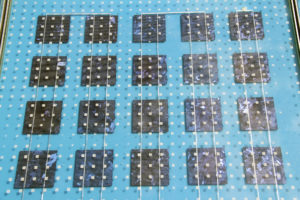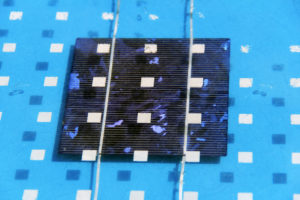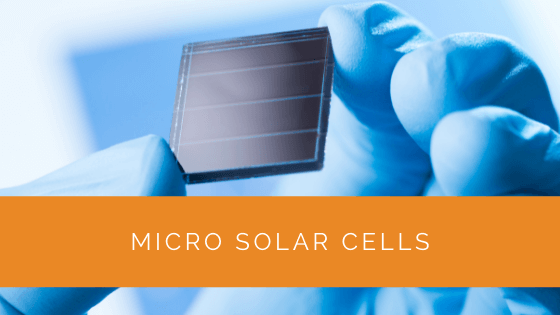Global fuel consumption poses a real threat to the environment. Choosing a solar system for domestic or commercial use can contribute to a greener environment. This electrical device is a great invention of materials science. It can convert energy straight from direct sunlight via the photovoltaic effect.
Emerging technology and numerous recent research and development breakthroughs for these efficient solar cells have created microscale solar cells. Do you know what they are?
These are smaller photovoltaic or solar cells capable of much greater light absorption. These microcells are estimated to absorb twice the amount of energy compared to conventional solar systems.
New cutting-edge engineering and technology have made the creation of this solar system possible. As the solar sector gains popularity, you will benefit from knowing about these unique solar panel systems.
Contents
- 1 Key Takeaways
- 2 How are Micro Solar Cells Made?
- 3 A Higher Solar Cell Efficiency Than Other Solar Panels
- 4 Case Study: Pioneering the Use of Micro Solar Cells in Urban Environments
- 5 Expert Insights From Our Solar Panel Installers About Micro Solar Cells
- 6 Discover the Power of Solar with Solar Panels Network
- 7 Final Thoughts
Key Takeaways
- Micro solar cells are small photovoltaic cells that can absorb twice the amount of energy compared to conventional solar systems, offering higher efficiency, better configuration, and lower manufacturing costs.
- These microcells are made by imprinting thin semiconductor layers, and they can be covered with tiny ball lenses to capture more sunlight, resulting in power conversion efficiencies between 25% and 35%, significantly higher than traditional solar panels.
- Micro solar cells create sunlight without cooling, making them suitable for various applications, including woven textiles, spacecraft, and even glass-enclosed aerospace solar arrays, promising a sustainable energy source Solar Cell.
A solar cell is the tiniest functional component of an electrical generator that uses solar energy. It is even considered the building block of the device. When it comes to generating solar energy, the importance of solar panel systems is indispensable.
These cells come in really small sizes, with each side of the cells being about 600 micrometres. These cells’ compact size and higher scalability make them useful in ultra-small-scall applications.
Since these microcells have less weight and higher efficiency flexibility, they are often helpful in weaving into any fabric and clothing. Moreover, manufacturing these cells is affordable using solar-cell microfabrication materials and simple semiconductors.
Despite their smaller size, these cells can use solar energy more efficiently than regular solar panels. Microcells offer three major benefits that make their traditional counterparts seem lower than them.
- High efficiency
- Better configuration
- Lower manufacturing cost
How are Micro Solar Cells Made?
Multiple solar cells are joined in a chain construction to form the solar panel systems, but how are the micro solar cells made? These tiny cells are built using active layers over the surface of a semiconductor layer, also known as semiconductor wafers. The thin layer needs to be very thin and divided into multiple pieces.
Afterwards, these thin semiconductor layers are treated similarly during the printing process. However, a chemical imprinting process is used to make the microscale cells instead of layer division.
Then, a different layer is attached to the previously treated semiconductor layers. This way, all the chemicals that can damage the added layer are absorbed away. This technique is excellent for separating the cells from the surface.
A robot bearing then moves over the layer and picks the cells up. This robot has a polymer stamp that places the cells over assorted ceramic backings printed with electrical contacts.
Only a thin part of the surface of this layer is used for making the cells. The fascinating factor is that even a 10cm or four-inch layer can produce 36,000 microsolar cells.

Grids and Scaffolds
Recently, many new developments in these microscale cells have made it a more scalable technology. Researchers at the Stanford University of California have successfully developed solar cells made from perovskite microsolar cells.
A hexagon-shaped scaffold is used to protect the cells. Now, the benefit of perovskite is that it is a low-cost material. On top of that, it produces a lot more energy than the usual silicon cells used in solar panel systems.
Also, silicon cells tend to be unstable. This is why perovskite is used to grant more stability to the cells. The structure is inspired by insects’ compound eyes and is divided into numerous tiny segments. This honeycomb structure has a built-in redundancy that allows it to work even if one segment is lost.
A Higher Solar Cell Efficiency Than Other Solar Panels
The micro-concentrator solar cells have much higher power conversion efficiencies than regular non-concentrated large-area solar cells. This helps bring down the power generation cost since the microscale solar cells use twice as much light.
Once the micro solar cells are created, very small, spherical, smaller “ball lenses” cover them. This helps in the uniform distribution of light. Moreover, these lenses capture sunlight from a wide angle.
Ideally, each microcell consists of three semiconducting layers. Each of these layers is capable of absorbing different band gaps of sunlight.
Another reason for their popularity is the lesser material needed for manufacturing due to the printing process. On average, micro solar cells’ efficiency can be between 25 and 35%.
This is huge since the standard solar panels could capture only 15 to 18% of renewable energy. As a result, these cells provide electricity at a much lower price than traditional solar panel systems.
Ability to Handle More Intense Sunlight
The best part about these cells is that they can absorb much more concentrated sunlight without cooling. Solar cells have been developed using innovative microprinting technology.
These solar panels consist of tiny high-concentration photovoltaics that promise to reduce material costs. If the cells are less than a millimetre, they become as efficient in handling heat as a one-sun panel.
The best part is that this is achieved without needing any additional cooling system, as the cells have a greater total area. A chemical etching is used instead of the usual sawing of the semiconductor wafer.
The rest of the process is similar, with a robot bearing the polymer stamp moving over the water.

Application in Woven Mesh and Fabrics
These tiny solar cells can be a reliable power source for various applications. They can be useful in everything from spacecraft to even your clothes. It may sound like science fiction, but even fashionable clothing can use these cells.
The Nottingham Trent University of UK has developed exactly that. They have been able to weave waterproof microsolar cells into textiles. These cells have a measurement of 3mmx1.5mm.
The goal of this is to create a washable, solar-energy harvesting textile. This solar-enabled clothing is expected to be revolutionary. A piece of clothing consisting of 2,000 cells can generate the power necessary for charging a cell phone.
Solar Cells Thinner Than Hair
There is more than one use of these cells. Take the textile-like photovoltaic material by the Sandia-developed technology, for example. The company, known as mPower Technology, has been able to use these cells in satellites.
These are also known as DragonSCALES, and Google’s latest constructions use these. The microcells are even thinner than human hair. DragonSCALES is a bendable sheet of these lightweight cells.
Potentially, these can be applied to the glass-enclosed aerospace solar arrays. This is a huge step up from using the costly Gallium Arsenides. Now, Gallium Arsenide is a limited-supply, highly expensive component. Till now, it was the only option available.
Case Study: Pioneering the Use of Micro Solar Cells in Urban Environments
Background
At Solar Panels Network, our mission is to harness cutting-edge solar technologies to drive sustainable energy solutions. With the increasing demand for renewable energy in urban environments, we identified micro solar cells as a promising technology that could meet the unique challenges of densely populated areas. Our goal was to demonstrate the practical applications and benefits of micro solar cells in a real-world setting.
Project Overview
We embarked on a project to integrate micro solar cells into a mixed-use urban development, which included residential apartments, commercial spaces, and public areas. The aim was to leverage the compact size and high efficiency of micro solar cells to generate significant energy while maintaining aesthetic appeal and functionality.
Implementation
- Micro Solar Cell Integration: Incorporated micro solar cells into building facades, rooftops, and even into public art installations to maximise energy capture.
- Advanced Energy Storage: Installed high-capacity battery systems to store energy generated by micro solar cells, ensuring a steady power supply.
- Innovative Design: Used thin, flexible micro solar cells that could be seamlessly integrated into various surfaces, including windows and outdoor furniture.
- Real-Time Monitoring Systems: Deployed advanced monitoring systems to track energy production and consumption, optimising efficiency.
Results
- Enhanced Energy Efficiency: The micro solar cells demonstrated a 30% increase in energy capture compared to traditional solar panels, significantly reducing the development’s reliance on grid electricity.
- Aesthetic and Functional Integration: The project successfully showcased how solar technology could be integrated into urban design without compromising aesthetics or functionality.
- Sustainable Urban Living: The development became a model for sustainable urban living, with residents benefiting from reduced energy costs and a lower carbon footprint.
- Scalability and Flexibility: The project highlighted the scalability and flexibility of micro solar cells, proving their viability for diverse applications, from architectural facades to portable devices.
Summary
This project underscored the transformative potential of micro solar cells in urban environments. By leveraging their unique properties, we were able to create a development that not only meets modern energy needs but also sets a new standard for sustainable urban design. The success of this project demonstrates that micro solar cells are not just a theoretical concept but a practical solution ready to be adopted on a larger scale. As we continue to innovate and expand our offerings, Solar Panels Network is committed to leading the way in integrating advanced solar technologies into everyday life.
Expert Insights From Our Solar Panel Installers About Micro Solar Cells
Micro solar cells represent a groundbreaking advancement in photovoltaic technology, offering unprecedented efficiency and flexibility. Their compact size and ability to absorb twice the energy of conventional panels make them ideal for innovative applications, from wearables to spacecraft.
Lead Solar Engineer
One of the most exciting aspects of micro solar cells is their potential to revolutionise urban energy solutions. With the ability to integrate into fabrics and building materials, they open up new possibilities for sustainable energy in densely populated areas.
Senior Renewable Energy Consultant
The production of micro solar cells using thin-film technology not only reduces material costs but also enhances their efficiency. This is a significant step towards making solar energy more accessible and affordable for everyone.
Chief Solar Technology Officer
Discover the Power of Solar with Solar Panels Network
Are you navigating the world of solar installations? Look no further than Solar Panels Network, the UK’s trusted partner in harnessing the sun’s potential. Our dedication goes beyond just installations; we’re on a mission to transform how homeowners and businesses across the UK perceive and utilise energy. By choosing us, you’re reducing your carbon footprint and making a smart financial move that promises savings for years ahead. Contact us today and embark on your solar journey.
Final Thoughts
Cost reduction is a key driving factor in research and development in the solar energy sector. Additionally, the increased efficiency of microsolar cells has made the industry quite competitive. It can very well be said that the solar energy sector will soon replace traditional fossil energy sources completely.
With global energy consumption rising, these photovoltaic modules can offer a sustainable energy source. Their significant power conversion efficiency (PCE) results from improvements in thin-film technologies. Overall, it can be said that in present conditions, there is a lot of scope for micro-concentrator solar cells.
About the Author
Solar Panels Network stands at the forefront of solar energy solutions, driven by a team of seasoned solar engineers and energy consultants. With over decades of experience in delivering high-quality solar installations and maintenance, we are committed to promoting sustainable energy through customer-centric, tailored solutions. Our articles reflect this commitment, crafted collaboratively by experts to provide accurate, up-to-date insights into solar technology, ensuring our readers are well-informed and empowered in their solar energy decisions.

